Recipes and ways to remove a variety of odors from clothes
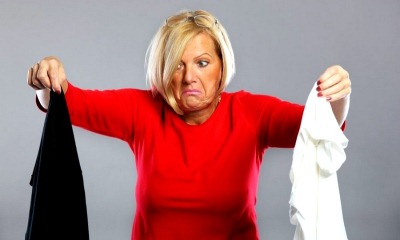 Things absorb unwanted odors very quickly, but getting rid of them is difficult.
Things absorb unwanted odors very quickly, but getting rid of them is difficult.
Fabrics have a different structure and color, so you need to use certain means to process them. Otherwise, along with the smell, you can lose the wardrobe item.
Read about how to remove various odors from clothes and not damage it in the article.
Content
Washing clothes correctly
Washing is the main method of combating odors on clothes. To ensure that this process gives the expected result and does not lead to damage to the product, you need to act according to the instructions:
-
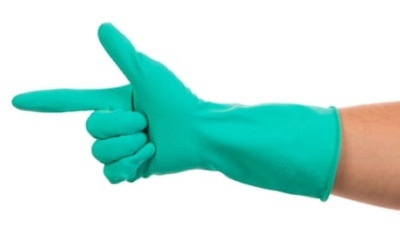 Before washing, read the information on the label. It is impossible to violate the recommendations for the temperature regime.
Before washing, read the information on the label. It is impossible to violate the recommendations for the temperature regime.In addition, there are products that are forbidden to be machine washed. Some things can only be dry cleaned at all.
- You need to wash things turned inside out to the wrong side.
- To get rid of the smell, you cannot do without pre-soaking. To prepare the cleaning solution, you need to use auxiliary products (folk or special).
- Pretreatment is required for both hand and machine wash.
- If there are stains on the linen - sources of smell, then they need to be worked out especially carefully.
- Smelling items are washed separately from other clothing.
- You need to rinse the products several times.
How to remove folk remedies?
Handy tools help to cope with the smell. You can disinfect fabric with turpentine and clay.
Mode of application:
- a cotton swab is moistened with turpentine;
- they pass over a stain that exudes a smell;
- cover the treated area with clay and press it with your palm;
- apply a white paper napkin on top and iron it with an iron;
- after processing, the item is washed as usual.
This method is effective when there is a slight odor stain on the product. If the smell comes from the whole thing, use soda.
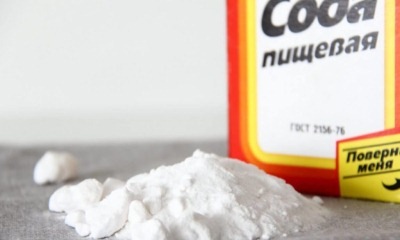 Mode of application:
Mode of application:
- Dissolve 0.5 cups of soda in two glasses of warm water.
- Pour the resulting solution into a basin with 3 liters of pure water, bring it to the desired temperature.
- The product is soaked for several hours. If the smell is strong, leave the item overnight.
- Wash clothes as usual.
The baking soda can be machine washed. It is poured into a compartment with a powder in the amount of 2 tablespoons.
You can deal with extraneous odors with a vinegar solution. He not only stops aromas, but also fights bacteria.
Procedure:
- 1 glass of table vinegar is added to a basin with 5 liters of water;
- soak things for an hour;
- washed according to the information on the tag;
- rinse clothes in acidified water - to prepare a homemade conditioner for 5 liters of water, потребуется cup of vinegar is required.
An effective and budgetary remedy for combating odors is ammonia.
Mode of application:
- A tablespoon of ammonia is dissolved in 5 liters of water.
- Soak the thing for half an hour.
- They erase it in the usual way.
Since ammonia has a pungent smell, you need to work with it in a respirator, or in a room with good ventilation.
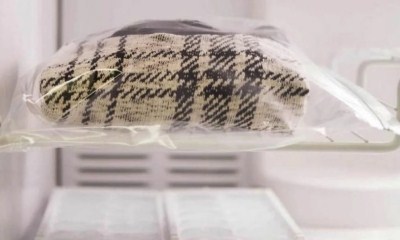 The quickest and least labor-intensive way to deal with foreign aromas is freezing.
The quickest and least labor-intensive way to deal with foreign aromas is freezing.
Procedure:
- smelling things are wrapped in cellophane, the bag is tightly tied;
- put the product in the freezer for an hour, if there is time, it can be left overnight;
- remove clothes, ventilate them in the fresh air.
This method allows you to cope with odors that are organic. In winter, things can be hung on the balcony.
How to quickly eliminate with special formulations?
There are specialized products on sale to combat odors. Top 3 best squads:
Gel Dr. Beckmann
Odor remover for clothes and linen safe for health, dermatologically tested... Eliminates persistent odors and prevents new ones. Suitable for all types of fabrics, works at any water temperature, can be combined with detergents. Price - 350 rubles.
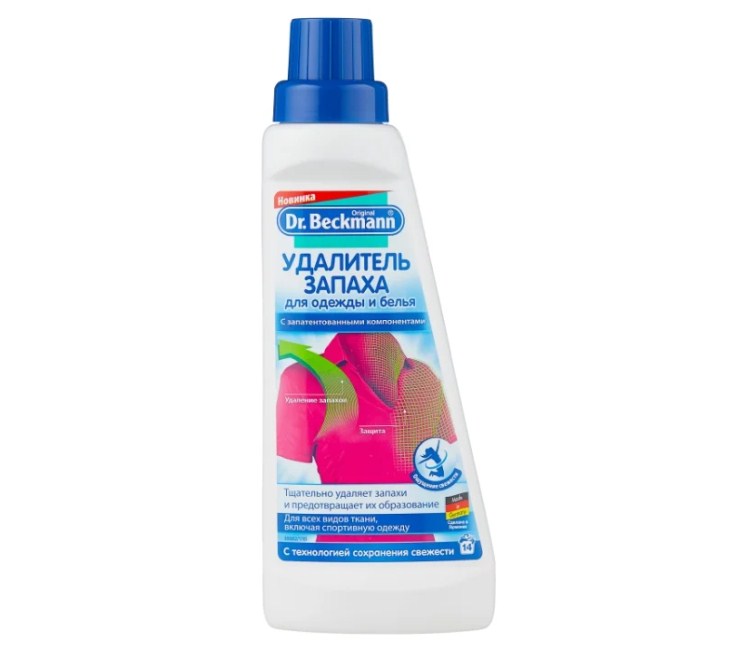
HG
Detergent Powder Amplifier against the unpleasant smell of sportswear. The product effectively removes foreign aromas, is suitable for washing towels and other textiles made of cotton and synthetics. It is used sparingly, one pack of concentrate is enough for 16 washings. The price is 400 rubles.
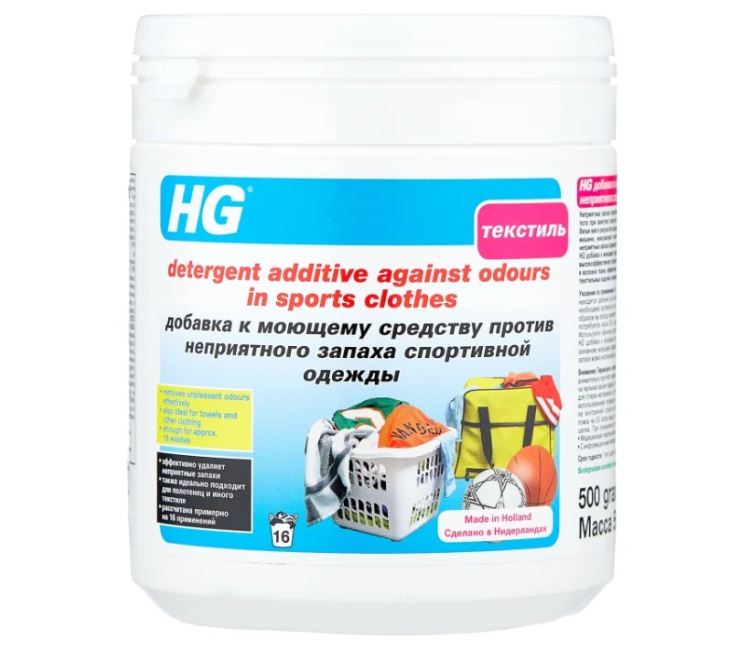
Helmetex spray neutralizer
The product does not require rinsing, does not leave marks and stains behind... Its advantage is its antibacterial effect. The spray is effective against molds. Price - 590 rubles.
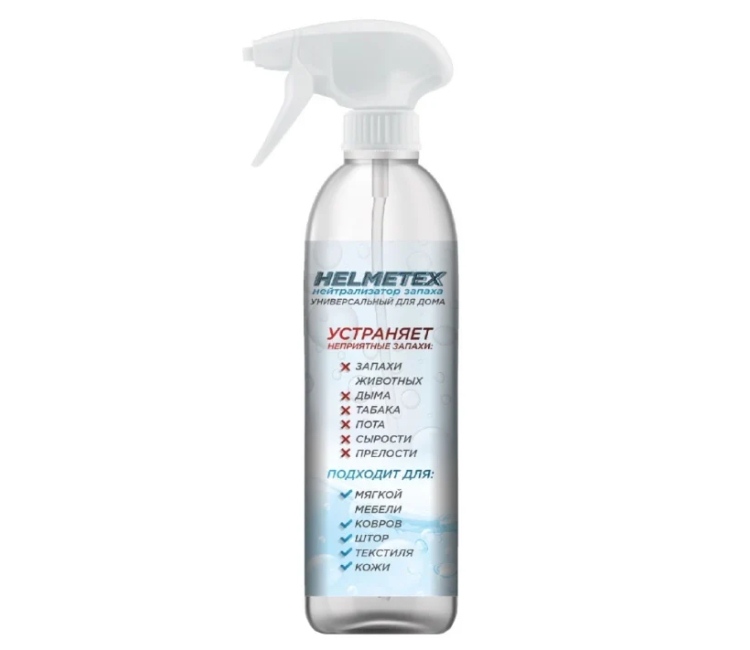
Features of the elimination of various unpleasant odors
Depending on what kind of smell comes from the clothes, the means to eliminate it will differ:
- New things... It is recommended to soak them in a solution of table salt (3 tablespoons per liter of water). After 30 minutes, the clothes are rinsed in clean water.
- Musty smell... You can get rid of it with potassium permanganate. The solution should not be too concentrated so as not to stain the product. This method is suitable for dark clothes. Light-colored fabric is treated with hydrogen peroxide.
- Smell of burning or fire... It is removed with a dishwashing detergent added in small amounts during hand washing.
- Solvent. It can be removed with alcohol, which is previously diluted with water in equal proportions. The problem area is treated with a sprayer, after which the product is sent to dry.
- Chlorine. Its smell well neutralizes soaking the product in a solution based on laundry soap.
- Kerosene. Liquid ammonia effectively copes with it. If the stain is local, the ammonia is used as a compress. They impregnate a cotton pad with it, which is applied to the contaminated area.
- Perfume. After washing in the pockets of the product, you need to pack bags filled with freshly ground coffee. It neutralizes the smell of even the most persistent perfume.
- Naphthalene. To combat this scent, things don't have to be washed. It is enough to sprinkle them with mustard powder and wrap them in newspaper. After a day, the mustard is swept away with a brush.
- Acetone. If things smell like acetone, it is enough to hang them out for several days in fresh air.
- The smell of Chinese things... Since low-quality dyes and materials are often used for their manufacture, preliminary soaking of the product in a soda solution is required.
- Sweat. It can be neutralized with crushed aspirin tablets. They are mixed with soda, add a little water. The resulting gruel is treated in the armpit area.
Nuances of processing different materials
Nuances to consider when removing odors from different types of fabric:
 Cotton. It is not recommended to process things in water above 60 degrees. Wash cotton better by hand. If the fabric is colored, then you cannot use products with a whitening effect.
Cotton. It is not recommended to process things in water above 60 degrees. Wash cotton better by hand. If the fabric is colored, then you cannot use products with a whitening effect.- Jeans. Dark jeans are prone to fading, so you need to ventilate them in the shade, protecting them from direct sunlight. Use ammonia with caution.
- Wool. Such products are recommended to be processed dry, sprinkling, soda or salt
- Leather. You can remove a smelly stain with a soapy solution. Wash leather products cannot.
- Suede leather. The fabric is afraid of water. To eliminate the unpleasant odor, the thing is ventilated. You can also use dry mustard powder. Intense friction of the product is prohibited.
- Linen. Can be soaked in different solutions and wash linen at high temperatures. This fabric is resistant to many cleaning agents.
Helpful information
Tips for removing unpleasant odors from clothes:
- smelling things cannot be stored together with other wardrobe items - otherwise you will have to wash the entire wardrobe;
- you need to start removing the smell as quickly as possible so that it does not have time to be deeply absorbed into the fibers of the fabric;
- after washing, things need to be dried and ironed - if you put them in a damp cabinet, the smell will return.
You will find a lot of useful and important information about removing various unpleasant odors from objects and surfaces in this section.
Conclusion
You can get rid of an unpleasant smell on your clothes with the help of improvised means. When choosing a composition, it is necessary to take into account the type of fabric and the characteristics of the substance that provoked the appearance of an extraneous aroma. Store-bought formulations are easy to use, save time, do not harm fabrics, but require financial costs.



